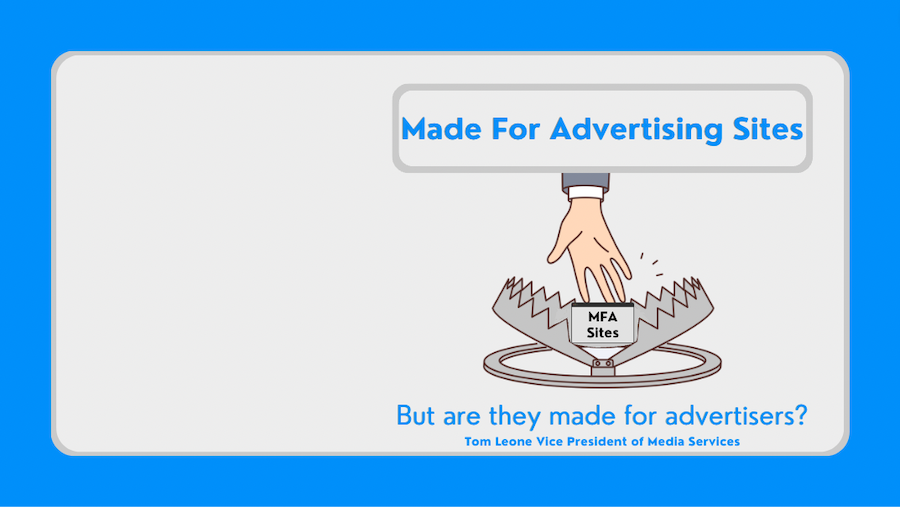These running shoes are “Made for Running” = made for runners
This gaming console is “Made for Gaming” = made for gamers
This smartwatch is “Made for Fitness” = made for Fitness enthusiasts
Surely when a website is “Made for Advertising” = made for advertisers, right?
Wrong.
Made for Advertising (MFA) websites are developed for one reason, and one reason only –– to deceive advertisers into spending money on impressions perceived to be valuable, but in actuality are far from it. The only parties benefiting from these Made for Advertising sites are the Supply Side Platforms representing their inventory and the “publishers” who are standing these sites up. They are providing little to no value to the brands running across their inventory.
So, what are MFA websites, anyway? First, let’s understand the size and impact of these nefarious sites. According to Digiday, ”MFA sites gobbled up a whopping 21% of the 35 billion impressions tracked by the study and a notable 15% of ad spend.” Forbes defines an MFA website as “websites created solely for ad arbitrage, leaving the actual content and user experience as afterthoughts. The result is a poor user experience, a negative brand association, and a wasted ad budget.”
MFA sites are a representation of everything that naysayers point to about the pitfalls of programmatic, and they are 100% correct. These sites create a murky marketplace by manipulating buyers with the allure of highly viewable, scalable, and affordable ad impressions –– a trifecta of temptation for an experienced buyer looking to maximize their marketing budget. These are metrics that trained buyers, platform algorithms, and artificial intelligence seek, and subsequently reward with bids and budget.
However, when looking beyond the spreadsheet and peeking under the hood, it becomes clear that these sites are driving little to no value for a marketer aside from hollow numbers. The tangible business results are not being realized because the ads are either not being seen (ad stacking, out of stream, high ad congestion), or they’re often within a poor user experience utilizing rapid auto-refresh or the dreaded ‘slideshow’ experience.
Unfortunately, the production of MFA websites is only becoming easier as revenue poachers can quickly ‘go live’ with the assistance of artificial intelligence to generate new content, SEO-friendly keywords, click-bait headlines, and other ways to leverage search engines and social media to generate page views. These deceitful actors are moving quickly and even monetizing YouTube TrueView ads to inflate their earnings. An explosive report written by independent researcher, Krzysztof Franaszek of Adalytics “finds that for years, significant quantities of TrueView skippable in-stream ads, purchased by many different brands and media agencies, appear to have been served on hundreds of thousands of websites and apps in which the consumer experience did not meet Google’s stated quality standards. For example, many TrueView in-stream ads were served muted and auto-playing as out-stream video or as obscured video players on independent sites. Often, there was little to no organic video media content between ads, the video units simply played ads only.”
The term “set and forget” is one we typically hear in this industry. At Brkthru, we believe that setting and forgetting should be reserved for crockpots, smart thermostats, and self-cleaning ovens. When it comes to the management of our client’s campaigns, we are on it 24/7. Zooming in and out –– monitoring inventory and campaign performance beyond the spreadsheet. We strive for real, tangible business results, not empty reporting metrics.
